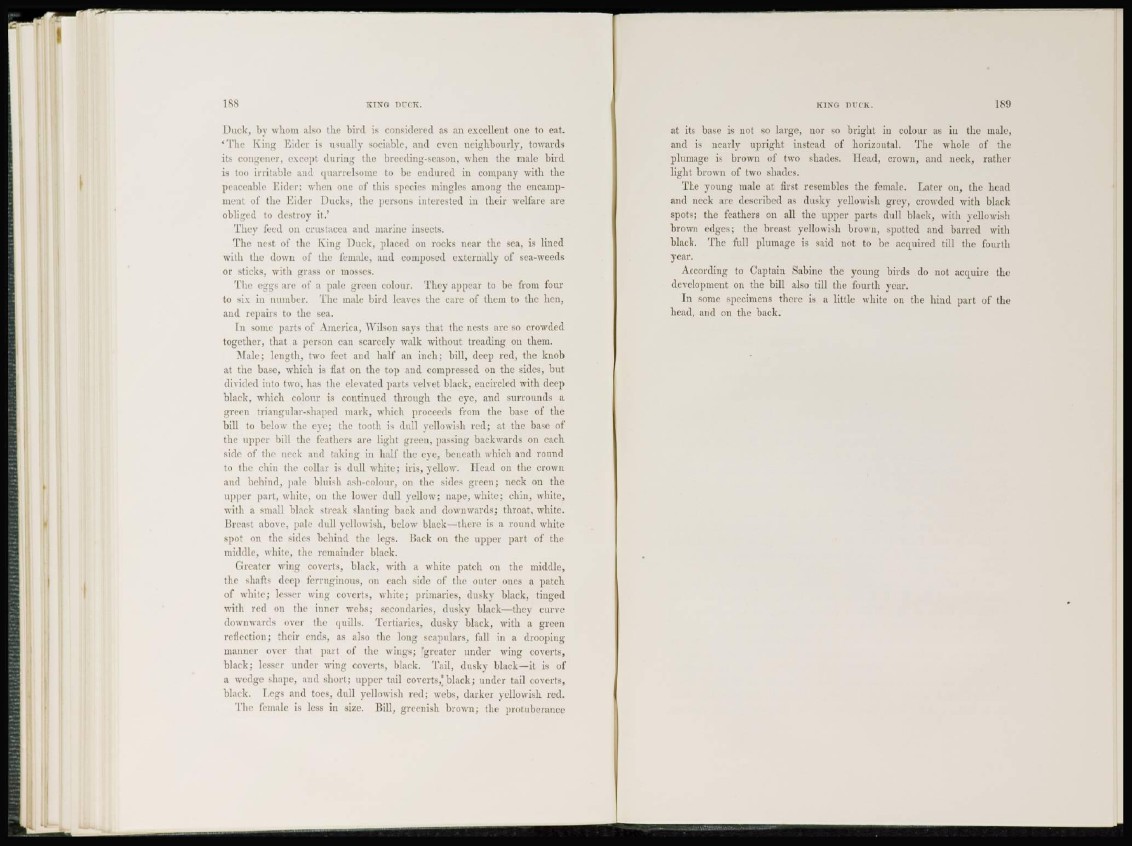
1 8 8 KING DUCK.
Duck, by whom also the bird is considered as an excellent one to eat.
' T h e King Eider is usually sociable, and even neighbourly, towards
its congener, except during the breeding-season, when the male bird
is too irritable and quarrelsome to be endured in company with the
peaceable Eider.: when one of this species mingles among the encampment
of the Eider Ducks, the persons interested in their welfare are
obliged to destroy it.'
They feed on Crustacea and marine insects.
The nest of the King Duck, placed on rocks near the sea, is lined
with the down of the female, and composed externally of sea-weeds
or sticks, with grass or mosses.
The eggs are of a pale green colour. They appear to be from four
to six in number. The male bird leaves the care of them to the hen,
and repairs to the sea.
In some parts of America, Wilson says that the nests are so crowded
together, that a person can scarcely walk without treading on them.
Male; length, two feet and half an inch; bill, deep red, the knob
at the base, which is flat on the top and compressed on the sides, but
divided into two, has the elevated parts velvet black, encircled with deep
black, which colour is continued through the eye, and surrounds a
green triangular-shaped mark, which proceeds from the base of the
bill to below the eye; the tooth is dull yellowish red; at the base of
the upper bill the feathers are light green, passing backwards on each
side of f l i e neck and taking in half the eye, beneath which and round
to the chin the collar is dull white; iris, yellow. Head on the crown
and behind, pale bluish ash-colour, on the sides green; neck on the
upper part, white, on the lower dull yellow; nape, white; chin, white,
with a small black streak slanting hack and downwards; throat, white.
Breast above, pale dull yellowish, below black—there is a round white
spot on the sides behind the legs. Back on the upper part of the
middle, white, the remainder black.
Greater wing coverts, black, with a white patch on the middle,
the shafts deep ferruginous, on each side of the outer ones a patch
of white; lesser wing coverts, white; primaries, dusky black, tinged
with red on the inner webs; secondaries, dusky black—they curve
downward over the quills. Tertiaries, dusky black, with a green
reflection; their ends, as also the long scapulars, fall in a drooping
manner over that part of the wings; "greater under wing coverts,
black; lesser under wing coverts, black. Tail, dusky black—it is of
a wedge shape, and short; upper tail coverts," black; under tail coverts,
black. Legs and toes, dull yellowish red; webs, darker yellowish red.
The female is less in size. Bill, greenish brown; the protuberance
K I N G N R C K. 189
at its base is not so large, nor so bright in colour as in the male,
and is nearly upright instead of horizontal. The whole of the
plumage is brown of two shades. Head, crown, and neck, rather
light brown of two shades.
The young male at first resembles the female. Later on, the head
and neck are described as dusky yellowish grey, crowded with black
spots; the feathers on all the upper parts dull black, with yellowish
brown edges; the brcasi yellowish brown, spotted and barred with
black. The full plumage is said not to be acquired till the fourth
year.
According to Captain Sabine the young birds do not acquire the
development on the bill also till the fourth year.
I n some specimens there is a little white on the hind part of the
head, and on the back.